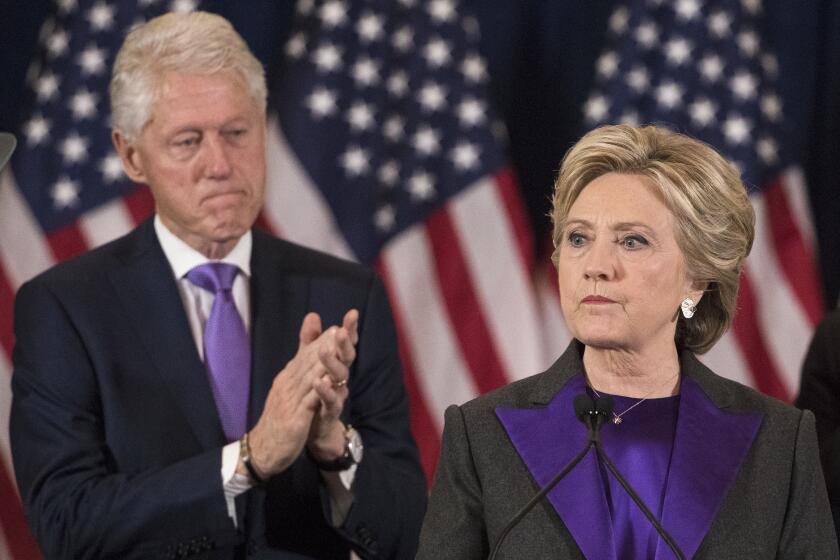Gov.’s Growth, Clean Air Plans Said to Clash
In his State of the State speech Thursday, Gov. Arnold Schwarzenegger declared war on dirty air. “Air pollution decreases our productivity and increases our healthcare costs,” the governor said. “It is time to consider clean air as part of our critical infrastructure.”
But for weeks, environmentalists had been warning administration officials that key aspects of the governor’s strategic growth plan could lead to worse air quality.
The issue came to a head in mid-December, when environmentalists on a task force set up to draft the governor’s plans for speeding the movement of goods through California balked at certain port and highway expansion projects. They said those projects, which are likely to be included in the governor’s proposed public works program, lacked adequate protections against increased air pollution from diesel-powered ships, trucks and trains.
“Southern California has the worst air pollution in the nation, and recent studies repeatedly have linked that pollution with illnesses and premature deaths,” said Andrea Hricko, a task force member and associate professor of preventive medicine at the USC Keck School of Medicine. “Yet the main thrust of the Schwarzenegger transportation expansion plan is to build more freeways, larger ports and more rail yards. That is not how we protect public health.”
Hricko said she was shocked at the administration’s draft plan in mid-December and was further disappointed by the governor’s speech. “Preventing disease and death from air pollution must be paramount, not a footnote to the Schwarzenegger administration’s transportation expansion plans,” she said.
Environmentalists were angry at a Dec. 20 draft “goods movement plan” that included such projects as expansion of the Long Beach Freeway, replacement of the Gerald Desmond and Schuyler Heim bridges in Long Beach and construction of a new rail yard in Long Beach.
Sunne Wright McPeak, secretary of the state’s Business, Transportation and Housing Agency and co-chair of the task force, defended the governor’s approach. She said Schwarzenegger was committed to a 50% reduction in air pollution by 2020.
McPeak said the goods movement plan, to be finished in June, will call for “continuous and simultaneous improvement” in environmental quality and infrastructure.
Julie Masters, a senior attorney with the Natural Resources Defense Council in Los Angeles, gave the governor credit for recognizing in his speech “the need to improve air quality and human health.”
But Masters, also a member of the goods movement task force, said the $2 billion the governor proposed to spend to improve air quality statewide is “not nearly enough.” Indeed, a plan drawn up by former L.A. Mayor James K. Hahn put the cost of reducing pollution associated with just the Port of Los Angeles at $11 billion to $14 billion over 20 years.
A state Air Resources Board study concluded last year that air pollution generated by California’s cargo industry would result in 750 premature deaths in 2005 and generate tens of billions of dollars in related healthcare costs over the next 15 years.
“Californians who live near ports, rail yards and along high-traffic corridors are subsidizing the goods-movement sector with their health,” the study warned.
Particulates, primarily from diesel engines, are associated with premature death, increased risk of cancer and heart disease, asthma and other respiratory illnesses, according to the report.
Schwarzenegger’s proposals for traditional infrastructure come as L.A. Mayor Antonio Villaraigosa and his harbor commission president are moving in a different direction -- toward alternative fuels and new technology such as monorail-type systems fueled by electricity.
“Putting in a truck lane doesn’t eliminate the air pollution -- at least, the last time I checked, it didn’t,” said S. David Freeman, president of the Los Angeles Harbor Commission, on Friday. “We need to be investing in 21st century technology, not 19th or 20th century technology.”
Schwarzenegger and other officials contend that, despite environmentalists’ concerns, air pollution can be reduced by building projects that speed movement of goods and reduce traffic congestion.
On Friday, the governor visited El Monte to underscore his support for a key project to speed the movement of cargo from the ports.
The $950-million Alameda Corridor East project would separate trains from auto traffic and speed the movement of rail cargo through the San Gabriel Valley and on to distribution sites in the Inland Empire.
Although Schwarzenegger did not specifically tout the project’s environmental benefits, he did repeat a reference from Thursday’s address: “It’s inexcusable that in the Central Valley, one out of six students go to school with breath inhalers” because of air pollution.
Its proponents contend that the construction of the new 35-mile-long corridor would eliminate more than 280 tons of air pollutants annually. But environmentalists fear it would just allow a greater volume of diesel-spewing trains and trucks, overwhelming any benefits of the project.
Some environmentalists indicated Friday that the administration had misled them. The task force process was “absolutely” a sham, said Penny Newman, a prominent environmental activist in the Inland Empire who participated.
“I think they brought who they had to bring to that table to bring some legitimacy, while all the time knowing where they were going,” Newman said.
Times staff writer J. Michael Kennedy contributed to this report.
More to Read
Get the L.A. Times Politics newsletter
Deeply reported insights into legislation, politics and policy from Sacramento, Washington and beyond. In your inbox three times per week.
You may occasionally receive promotional content from the Los Angeles Times.










